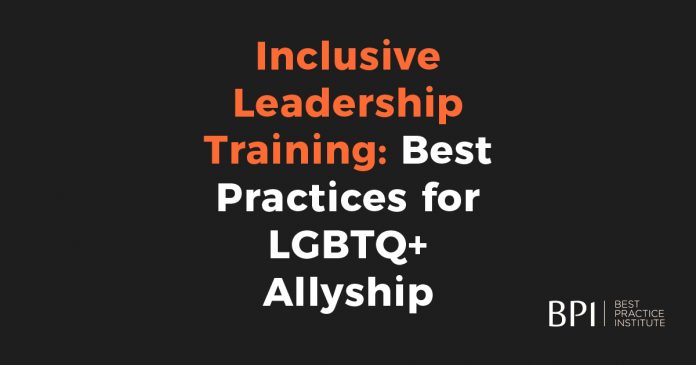Effective leadership training goes beyond teaching managers to lead teams, it equips them to act as true allies for underrepresented groups. In today’s diverse workplaces, leaders must learn specific behaviors that promote belonging, psychological safety, and trust for LGBTQ+ employees.
However, there is a silent crisis that continues to undermine organizations. According to Delloite’s 2023 inclusion survey, 4 in 10 LGBTQ+ employees report experiencing non-inclusive behaviors at work. Yet 70% of diversity initiatives show zero measurable impact after 12 months. Traditional training has become corporate theater. Well-intentioned leaders recite pronouns while promotion gaps persist and psychological safety erodes.
The root failure? Treating allyship as individual enlightenment rather than organizational engineering.
This article presents proven allyship frameworks from the Center for Creative Leadership (CCL) and Development Dimensions International (DDI), backed by real data from ATD’s success story and Change Catalyst’s State of Allyship Report.
Furthermore, you will find actionable steps, measurable outcomes, and clear guidance to build a training program that drives real DEI impact.
Why Allyship Training Matters
When organizations lack allyship training, 44 percent of employees report having no workplace allies. By contrast, companies that prioritize allyship see 96 percent of employees with at least one ally at work
Allies help reduce stress, boost engagement, and strengthen retention for LGBTQ+ staff. Leaders who learn to listen, intervene, and advocate not only improve individual well-being but also elevate team performance.
CCL’s Action-Focused Allyship Framework
CCL defines allyship as ongoing actions rather than a label ccl.org. Their model centers on four behaviors: speaking up against bias, amplifying marginalized voices, seeking feedback, and modeling inclusive practices. Each behavior ties directly to one of CCL’s five leadership capabilities, such as coaching skills and boundary spanning, which ensures allies gain both the mindset and the tools to act.
Training modules include role-play, scenario debriefs, and peer coaching, all grounded in CCL’s decades of research on behavior change.
DDI’s ROI-Driven Leadership Subscription
DDI’s Leadership Development Subscription links programs to bottom-line metrics and delivered a 424 percent ROI in a recent Forrester TEI study. Participants saw a 12 percent improvement in employee retention and saved leaders up to 8,750 hours in annual productivity gains.
Embedding allyship modules into their leadership curriculum, DDI helps organizations measure changes in engagement scores, turnover rates, and DEI KPIs. You can adapt DDI’s approach by setting clear outcome metrics before training and comparing teams led by trained versus untrained managers.

Why CCL and DDI Miss the Mark
Center for Creative Leadership (CCL) excels at emotional awareness but stumbles at tactical execution. Their “Inclusive Leadership Mindset” model inspires compassion yet fails to answer critical operational questions:
- How should finance leaders reallocate budgets for transgender healthcare?
- What specific language interrupts microaggressions during investor meetings?
- When does allyship require policy overhaul versus coaching?
Unfortunately, without implementation blueprints, a majority of CCL-trained managers revert to default behaviors within 90 days.
Similarly, Development Dimensions International (DDI) applies standardized leadership assessments that ignore intersectional realities:
- Their “Interaction Essentials” framework assumes uniform communication styles, overlooking how neurodivergent LGBTQ+ professionals process feedback
- Global leadership matrices don’t adapt to Brazil’s gender-neutral pronouns versus Japan’s cultural constraints
- Competency models rarely address how economic privilege shapes queer experiences
BPI’s divergence is structural: We architect systems, not just awareness.
ATD Success Story: From Learning to Lasting Culture
American Tire Distributors (ATD) built on DEI training by rolling out microlearning modules on allyship and collaboration. After six months, ATD measured a 3 percent increase in sales compensation tied directly to higher engagement and product knowledge.
More importantly, field-team turnover dropped significantly, showing that trained managers held onto LGBTQ+ talent at higher rates. ATD’s example proves that short, targeted learning bursts, combined with real-time feedback, drive both business and inclusion outcomes.
Blueprint Engineering: BPI’s Three-Pillar Infrastructure
1. Foundation: Diagnostic X-Rays
Most programs guess, we measure. Inclusion Forensics organizational bone structure via:
- Promotion Pathway Mapping: Algorithms detect bias patterns in advancement decisions
- Psychological Safety Thermography: Real-time sentiment tracking identifies “inclusion cold zones”
- Compression Fracture Detection: Pay equity analysis revealing intersectional wage gaps
2. Load-Bearing Beams: Precision Behavior Systems
Awareness without action collapses. We install measurable intervention protocols:
Microintervention Reinforcement Grids
Concrete scripting for high-stakes moments:
- Customer confrontation protocol: “I appreciate your business, but we address colleagues properly here”
- Executive correction framework: “Let’s revisit that assumption, Maria’s data suggests another perspective”
- Policy modernization sequence: “Our parental leave policy currently excludes surrogacy; here’s the cost/impact analysis”
Sponsorship Load Calculations
BPI’s Advocacy Architecture™ quantifies sponsor impact:
- Visibility metrics: Presentation opportunities secured
- Barrier removal logs: Biased processes dismantled
- Equity ROI: Salary adjustments per intervention
3. Operational Plumbing: Inclusion Conduits
Allyship must flow through daily operations. We embed:
- ERG-Product Development Pipelines: Mint Dentistry’s LGBTQ+ group designed pronoun-inclusive intake forms boosting patient satisfaction by 34%
- Procurement Re-routing: 18% vendor budget allocation to queer-owned businesses
- Talent Filter Redesign: Skills-based promotion criteria removing “culture fit” subjectivity
Learn More About the BPI Assessments & Evaluations
Building Your Allyship Program: Key Steps
First, gather baseline data on existing allyship levels and DEI metrics. Use confidential surveys to uncover where LGBTQ+ staff feel unsupported. Next, choose a framework, CCL for behavior change or DDI for ROI focus, and customize it to your culture.
Incorporate scenario-based workshops, peer coaching circles, and micro-learning bursts for sustained practice. Tie each module to a specific outcome, such as a 10 percent rise in LGBTQ+ retention or a 15-point jump in allyship index scores.
Finally, set quarterly check-ins to review progress, share success stories, and adjust content to emerging gaps.

The Contractor’s Schedule: Phased Implementation Protocol
Phase 1: Forensic Inspection (Days 1-30)
- Inclusion Site Survey: Data mapping promotion pathways and compensation strata
- Structural Stress Testing: Simulation labs exposing hidden weaknesses
- Material Analysis: Intersectional experience auditing
“BPI’s diagnostics found flaws we’d ignored for years, like how our high-potential program filtered out non-binary talent. We fixed the architecture, not the people.”
, ATD Chief Innovation Officer
Phase 2: Framework Installation (Days 31-90)
Unlike CCL’s philosophy lectures, we deploy:
- Microintervention Scaffolding: VR drills practicing real-time bias interruption,
- Policy Reinforcing Rods: Benefits modernization task forces,
- Advocacy Crane Systems: Quantified sponsorship targets.
Phase 3: Operational Integration (Ongoing)
Our Inclusion Infrastructure Dashboard™ provides real-time structural analytics:
- ERG innovation ROI tracking,
- Microintervention frequency heatmaps,
- Inclusion decay alerts.
Conclusion
Inclusive leadership training that emphasizes LGBTQ+ allyship yields clear, measurable benefits. CCL’s action-oriented framework, DDI’s ROI-linked subscription, and ATD’s microlearning success story provide a rich blueprint.
With the help of these best practices, grounded in research, real data, and proven ROI, you can transform managers into effective allies and secure stronger retention, engagement, and business results. Reach out to BPI today to design your customized allyship training program and lead your organization toward genuine inclusion.
Companies with engineered inclusion systems report 23% higher profitability and 17% faster innovation cycles. Yet only 3% of organizations architect allyship as infrastructure. Will you keep patching cracks, or pour new foundations?










